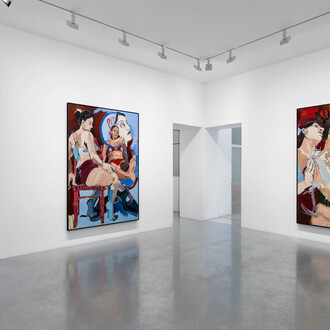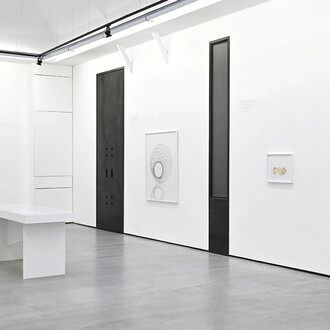Perrotin is pleased to present Josh Sperling’s second exhibition in Paris. So It Goes explores two ambitious developments in the style of the artist who, for the occasion, will take over the spaces of 10 Impasse Saint-Claude. The architecture of the building here plays a key role in the intervention by the American visual artist. This personal exhibition reveals a previously unseen facet of the artist’s work, which tends towards minimalism. Between painting and sculpture, his referenced and spontaneous practice rests on an intuitive and dynamic exploration of form. Josh Sperling usually decides on the use of colour at the last moment, after the production of the works he ‘composes’, in his own terms. In the process of refining their fabrication and installation, he skilfully deploys his technique and opens himself up to new possibilities.
In a first room, five circular groups respond to each other with their own logic and alternately involve familiar motifs featuring a variety of a priori dissonant colours. These five tondi are the result of Josh Sperling’s recent experiments. The juxtaposition of different canvases, followed by the shifting and multiplication of these surfaces, aims to create systematic volumes.
The execution of this gesture can be observed in this monumental series in which these large formats display rings, interlacings and spirals generated by this action of an almost sculptural nature.
The all-over monochrome is then used for the first time by the artist to activate the squiggle motif. This ‘squiggle’ evokes the game of the same name invented by pediatrician and psychoanalyst Donald Winnicott. Following a multicoloured mise en scène at the Perrotin Tokyo, it is presented here entirely in black, giving rhythm to each of the walls. It helps to immerse the spectator in an almost psychedelic momentum. These squiggles bring to mind the heightened contours and vivid forms of the graphic design that was all the rage in the 1980s. An era when technological innovations were accelerating and spreading through the creative sector and society as a whole. They also evoke the symbols of an ancient language, such as that of the Iroquois, from which Oneonta, the name of the artist’s hometown at the foot of the Catskill Mountains, allegedly comes, and which is now a locus for the hippie community.
Born in 1984 in Oneonta, New York, Josh Sperling was influenced by geometric abstraction and American minimal painting of the 1960s and 1970s with the discovery of leading figures such as Ellsworth Kelly and Frank Stella, but also pop culture. The artist merges these influences into combinations of shapes and colours in a spirit of collage. The artist also draws inspiration from historical movements such as Googie, an architecture commonly referred to as atomic, which emerged in parallel with the conquest of space and is specific to the signage of California’s shops and highway services in the 1950s. Also attracted by visual references related to postmodernism, like the zigzags of the Memphis movement, taken up by MTV’s famous chameleon logos during the 1990s, the artist’s imagery is both composite and personal.
Trained in cabinetmaking and then graphic design, Josh Sperling finally became interested in design for its formal character and the impact of its aesthetics on visual culture. The digital interface, the frame and the canvas constitute the bulk of the tools that define his work method that involves both conception and creation. His paintings are first drawn on a computer before becoming canvases stretched to the utmost, but not on threedimensional frames. This formalism also underlines the artist’s insatiable curiosity, both for mathematics and high-quality craftsmanship as for the architecture and design archives available online.
If the process by which Josh Sperling imagines and assembles these image-objects is thus calibrated, their presentation has until now been the result of a random approach. The artist here takes advantage of the exhibition space of Perrotin in an open reflection between the culture in which the image is embedded and the space-time in which the object is embedded. The lighthearted chromatic synthesis of his compositions is nowadays combined with a lyrical sensitivity and a tangible fullness in an age devoted entirely to the digital world and where utopian desires are a thing of the past. Josh Sperling lives and works in Ithaca, New York.
















